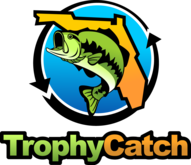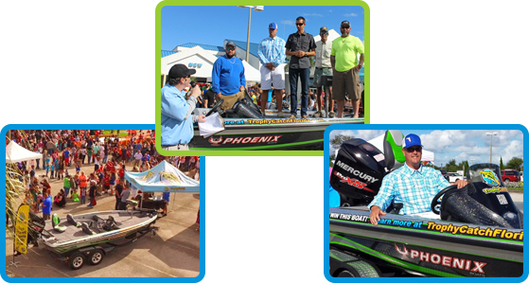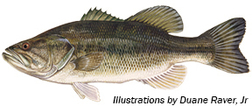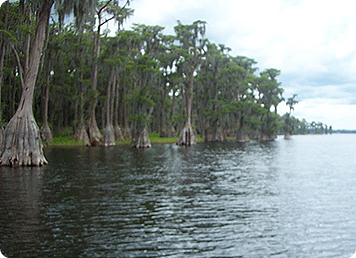 TrophyCatch Season 3 ended with a bang as a number of anglers got their submissions in just under the deadline! In addition to the news we reported in Issue 3, some late-breaking program highlights are below.
■ Over 1,700 trophy largemouth bass weighing 8 lbs or more were submitted in Season 3, more than doubling the bass submitted in the previous two years for a total of almost 3,000 bass caught-and-released!
■ TrophyCatch registration is now over 11,700 as word of the program grows.
■ Ed
Prather (below right), a lucky TrophyCatch participant, was the final drawing winner of the
Phoenix Boats bass boat powered by Mercury engine and MotorGuide trolling motor and anchored by Power-Pole! All registrants receive one chance at the prize for
registering, and every verified TrophyCatch club winner gets an additional 10
more chances. See the news release and video for more details.
|
 |
■ Last-minute
submissions brought Season 3's Hall of Fame total to an incredible 17 giant
bass 13 pounds or larger, but no one could beat Seth Chapman's 15-pound, 11-ounce monster from
Kingsley Lake! At the Hall of Fame awards ceremony held at Bass Pro Shops
Orlando, Seth (below center, with family) received the Championship Ring provided by the American Outdoors
Fund, and each Hall of Fame angler received an awesome free replica mount of their catch
from New Wave Taxidermy along with a beautiful plaque from American Registry, a
new TrophyCatch partner. This video captures the excitement of the event!
■ TrophyCatch
teamed up with Keep America Fishing to keep our bass habitat clean and free of litter. By signing the Pledge to Pitch It
anglers commit to keeping their worn-out soft plastic lures in the trash and out
of the water!
All these activities help to achieve TrophyCatch's goals, which are to preserve these valuable trophy fish through catch-and-release, improve how FWC creates or enhances trophy fisheries, and promote recreational fishing. You
can keep up to date on TrophyCatch promotions, special events and our top
producing anglers by liking our TrophyCatch Facebook page and subscribing to the TrophyCatch YouTube Channel. Plus you can find other outstanding
promotions of Florida's freshwater fishing and conservation efforts through a
variety of print and online media like newspapers, magazines, blogs, online
news outlets and video channels like Sportsman’s
Adventures with Captain Rick Murphy.
 Size: The state record is 17.27 lbs, though several larger fish have been reported but not certified. Any bass 8 pounds or larger is considered a trophy, and eligible for FWC's program (see above—bass must be released). The Big Catch minimum qualifying sizes are 24 inches or 8.0 pounds for adults, and 18 inches or 6.0 pounds for youth (BigCatchFlorida.com).
Identification and similar species: The Largemouth Bass is the best known and most popular game fish in
North America. It is distinguished from other black bass species found in Florida (Shoal, Choctaw, Suwannee and Spotted basses) because the
upper jaw extends beyond the rear edge of the eye, giving the largemouth its name. The first and
second dorsal (back) fins are also separated by an obvious deep dip.
|
Largemouth Bass: Upper jaw extends past eye, and first and second dorsal fins are separated.
Shoal, Choctaw, Suwannee and Spotted basses: Upper jaw does NOT extend past eye, and first and second dorsal fins are connected.
The Largemouth Bass is found statewide, but the other black bass species have more restricted ranges.
Angling qualities: The Largemouth Bass is king of Florida's freshwater fishing! Seventy percent of our 1.4 million freshwater anglers target bass, generating well over $1.25 billion in annual economic impact. This aggressive fish will strike almost any artificial, but plastic worms, minnow imitations, crankbaits, spinnerbaits, and various topwater lures produce the most bass. Flipping with jigs or plastics in heavy vegetation will often take fish when other methods fail. The best live bait is a golden shiner, fished under a float or
free-lined. Typical bass tackle consists of a medium to medium-heavy rod, matched to a spinning or baitcasting reel spooled with 8-20 pound monofilament or braid depending on fishing conditions.
Where to catch them: As the "Bass Fishing Capital of the World" Florida offers many excellent opportunities, but some of the "Top Spots" include West Lake Tohopekaliga (Lake Toho), Lake Kissimmee, Lake Istokpoga, Winter Haven South Chain of Lakes, Lake Okeechobee, Everglades Water Conservation Areas 2 and 3, Tenoroc Fish Management Area Lakes, and Lake Weohyakapka (Walk-in-Water).
Black Bass Regulations Review: The Florida Fish and Wildlife Conservation Commission (FWC) adopted the Black Bass Management Plan (BBMP) in 2011 to guide future management and conservation of black bass populations. The goal of future regulations is optimum sustainable use of Florida’s bass fisheries, with emphasis on high quality and trophy bass. Our vision is to simplify regulations where possible, while still providing diverse angling opportunities that promote high angler satisfaction. Based on a review of biological and sociological data, the FWC is proposing the statewide regulation for black bass (Largemouth, Shoal, Choctaw, Suwannee, and Spotted basses) be a five fish daily bag limit, only one of which may be 16 inches in total length or longer.
In the Suwannee River, areas north and west of the Suwannee River, and in any tributary river, creek or stream of the Suwannee River: Shoal, Choctaw, Suwannee, and Spotted Bass less than 12 inches in total length must be released immediately and only one black bass may be 16 inches in total length or longer. For additional information and to provide input via our black bass regulation survey, please check myfwc.com/fishing/freshwater/black-bass/bass-regulations/.
 No lure defines bass fishing like the plastic worm. When you see someone
with a 10-inch purple worm dangling from their rod tip, you just know
that you’re meeting a fellow hawg hunter! Plastic worms have been
putting bass on the hook for decades, and for good reason. First, worms
are easily rigged weedless, letting you reach bass a
crankbait can’t touch. They’re also fairly economical, so when you do
sacrifice a worm to a brushpile it doesn’t break the bank. (Though all
anglers should sign the Pledge to Pitch It and commit to dispose of their worn-out soft plastic lures properly!)
Finally, plastic worms are so soft that bass will often hang on to them
long enough for even beginners to get a solid hookset.
|
Styles: There are too many variations, both subtle and bizarre,
to cover all of them here. However, most modern offerings will fall
under either the “curly tail” or “no tail” category. I’ve always
preferred worms with a swimming tail
to add more action to my retrieve. The curly tail on a worm can vary
from a simple crescent-moon curl to longer ribbon-tailed offerings. But
you don’t need a tail to catch bass. “Do-nothing” or finesse worms put
plenty of fish in the boat, too. These straight or “stick” worms can be
rigged and fished in the same ways as more traditional worms, and may be
just the ticket when finicky bass become wary of more typical
offerings. These worms are usually tapered like traditional worms, sans
the tail.
History: The “rubber” worm has been around for over a century, with the
first patent reportedly filed in 1877. Early attempts were made of rubber resulting in a fairly stiff bait with little
action and poor buoyancy. Modern worm
angling really had its start in the late 1940’s, when Nick Creme
concocted a soft vinyl worm formula on his home stove. The Creme Wiggle
Worm hit the market in 1951, and bass fishing hasn’t been the same
since! There are now countless variations on that original design, with an amazing array of colors available. Although there are now plastic
curly-tail jigs, crawdads, frogs, lizards and even outlandish-looking creature baits, worms still outnumber the rest of the plastic-bait
crowd. And with good reason—even after a hundred years, bass haven’t
stopped eating them!
Rigging: The two best-known worm rigs are the Texas rig and the
Carolina rig. I see—and use—the Texas rig most often. This involves a
direct line connection to the worm hook, with a sliding worm or cone
sinker in front of the worm. This is a great rig for most situations,
and will allow you to snake a worm in and out of vegetation, stickups,
or other structure without hanging up. Use the minimum amount of weight
to get the job done. In fact, when fishing floating or extremely shallow
vegetation, I sometimes forego the worm sinker entirely and fish the
worm solo across the top of the vegetation, or just below the surface.
A Texas rig (top) and Carolina rig (bottom). The Texas rig is the simplest and most popular.
The Carolina rig is great for fishing a weedy or otherwise cluttered
bottom. A two-to-three foot leader is tied to the worm hook on one end
and to a barrel swivel on the other. The swivel is tied to your main
line, with an egg sinker ahead of it. When rigged with a floating worm,
this setup will allow you to work the bottom while the worm hovers above
the clutter to attract a bass’ attention. Some anglers claim superior
strike detection over the Texas rig with this method.
Basic techniques: One of the best things about plastic worms for beginning bass anglers is that it’s practically impossible to fish a worm wrong. I’ve had bass hit a worm while I was skimming it rapidly back across the surface after a bad cast, and when it was lying still on the bottom while I switched to another rod. If there’s such a thing as an “average” worm retrieve, it is probably bumping the worm along the bottom or through likely-looking cover, while allowing the worm to drop or rest momentarily and throwing in occasional twitches. Worms with curly tails can simply be reeled steadily through the water, though varying the retrieve will draw more strikes. Plastic worms work well for flipping, too. Although worms are nearly always worked slowly compared to other lures, you should go even slower when especially hot or cold weather slow the fish down.
Colors: You don’t have room in your garage for all the worm colors out there. However, keeping it simple can still provide results. If I had to pick only one worm color, it would be black. Popular second choices—in no particular order—would include red shad, watermelon, pumpkinseed, purple (grape) and motor oil. While bass definitely demonstrate color preferences, at least one of these time-tested standbys will usually produce fish at any given time.
The strike: Pay attention, because a bass might hit a plastic worm at any time. I’ve had bass grab a worm while it was sinking to a desired depth, and while it was sitting motionless on the bottom. Strikes can be hard or subtle, and I usually keep my rod tip high and my line taut in order to best detect them. You can’t judge the size of the fish by the size of the strike; a friend that caught his biggest bass—a 12-pounder—on a worm barely felt the take. If you think you’re not detecting subtle strikes, examine your worm for tiny “prickle” marks on the main body indicating it was picked up by a bass. Thankfully, the typical worm strike is usually more noticeable. A sharp tap-tap-tap or your line visibly twitching or moving off to one side will tell you that you’ve got a customer. I’ll usually lower my rod tip and then set the hook as soon as the slack is taken up by the fish. Don’t wait too long to set the hook, as bass will readily swallow plastic worms and become gut-hooked.
If you think you’re missing strikes, check for telltale patches of
“prickles” on the worm. Prickles on the main body of the worm usually
indicate bass strikes, while those found on the end or curly tail of the worm are probably panfish hits. |
|
 |
There are many other techniques and topics related to plastic worms that
could be covered here. However, this should be enough to get any angler
started down the road to catching more bass with the venerable plastic
worm!
 Size: 5,850 acres.
Location: Alachua County.
Description: Santa Fe
Lake is situated near the town of Melrose, roughly 20 miles northwest of
Gainesville in north-central Florida. Designated by the Florida Department of Environmental Protection as an
Outstanding Florida Water, this headwater of the Santa Fe River is known for
its amber-tinted tannic, yet clean water, sandy lake bottom, and outstanding fish and
wildlife habitat. Santa Fe Lake consists
of a smaller lobe to the north (“Little Lake Santa Fe”) and a larger main area to the south
(“Big Lake Santa Fe”) which are connected by a narrow pass.
While houses and boat docks line portions of the lake, much of the
shoreline consists of extensive areas of cypress trees and native emergent
plants such as maidencane and spatterdock.
In certain spots, this groundwater-fed lake can reach depths of up to 30
feet. Due to its deep, spring-fed
nature, Lake Santa Fe often continues to provide stable water levels and reliable access,
even when other nearby lakes are suffering from drought.
In
spring FWC electrofishing samples, Santa Fe consistently boasts high catch
rates for Largemouth Bass (1.39 fish per minute in spring 2015) when
compared to other lakes around the state. The lake’s healthy bass population is not lost on anglers,
as evidenced by the large number of tournaments held on the lake, especially in
the spring. While the lake may lack an
abundance of submersed aquatic plants, its well-defined ring of cypress trees,
maidencane, spatterdock and other emergent plants provides an
easily-identifiable zone in which to target fish, especially as they begin to
move into shallower water in winter and spring in preparation for spawning. Popular tactics for bass include
flipping and pitching soft plastics around cypress trees, docks, and in holes
in shoreline grasses. Anglers can also
do well throwing spinnerbaits and crankbaits, or slow-trolling live golden
shiners along grass lines adjacent to open water. Interestingly, one popular tactic employed on
the lake involves using jigging spoons to target schooling bass in deeper
waters. Anglers
should also target the pass between the big and little lakes as bass often
concentrate here in this "pinch point" in search of schooling baitfish. Santa Fe can have a reputation for being a challenge,
but anglers willing to adjust their techniques according to the available habitat
and put in their time learning the lake should be rewarded with good numbers of
keeper fish.
Lake
Santa Fe is also known for its quality crappie, bream, and catfish fisheries. In addition, FWC biologists have stocked the
aggressive and hard-fighting sunshine bass (a cross between a striped bass and
a white bass) in past years to provide additional angling opportunities. Because of its clean water and sandy bottom,
Lake Santa Fe is also popular with pleasure boaters, jet skiers, and wakeboarders
during certain times of the year.
Anglers wishing to avoid those activities should focus their fishing
efforts during weekdays. The lake has
four boat ramps available to the public.
For more information about Lake Santa Fe, check our Fishing Forecast and local contacts Chappini's Bait & Tackle (352-475-9496) and Bald Eagle Bait and Tackle (352-473-6060).
|
 |
This quarter puts us in the peak spawning period for Florida largemouth bass.
Spawning plays a very significant role in the lives of nearly all fish. This
activity is usually initiated by a rise in water temperatures, and different
species will start spawning at different temperatures. The spawning period is
usually the most demanding time in a fish’s year: body resources are diverted
to production of eggs or milt; territorial disputes and protecting a bed demand
energy while at the same time a fish is not free to feed; and protective
behaviors may result in injury (even fanning out a bed can abrade skin). All of
these factors place a high level of stress on a fish’s body, and any injuries
can invite infection during a time when a fish’s immune system has already been
weakened by stress. These are some of the reasons that many fish are
observed with sores or lesions during this part of the year. The information below is specifically for
Florida, as annual water temperatures (and therefore initiation and duration of
spawning) can vary markedly from state to state.
 Largemouth Bass have been known to spawn between December-June
in Florida, but by far most spawning occurs February-April. The triggering water
temperature for bass is between 62-75 degrees F. The smaller male will build a shallow
nest between 20-30 inches in diameter (roughly twice the size of the individual male
building the nest). The female will lay her eggs in the bed, and the male will
fertilize the eggs as they are released. Large females may lay as many as
100,000 eggs. Following spawning the male will continue to guard the eggs,
which usually hatch within 3-4 days. This parental protection will continue
another 2-1/2 to 3 weeks while the bass fry congregate in schools, ending once the
fry reach approximately 1/4-3/8 inch in size and begin to disperse.
|
Most trophy largemouth bass in Florida are caught during the peak spring spawning months of February-April. This is an excellent example of the citizen-science data that the TrophyCatch program is generating.
 Bluegill will breed between April-October, but May-June are the
peak months. A temperature between 78-80 degrees F will usually trigger spawning in
this species. This fish will nest in dense colonies, with one bed often
touching the next. The male will fan out a saucer-shaped bed, and the female
will deposit between 4,000-60,000 eggs. The male will guard the eggs (they
usually hatch within a day and a half), and will continue to guard the young
fry for several days.
In
south Florida, Redear Sunfish (shellcracker) may spawn as early as the
last week of February but more likely around the fourth week of March.
In central Florida, they could first go onto spawning beds during late
March. In the panhandle, they will likely
begin to concentrate in the third or fourth weeks of May. Redear Sunfish
may bed well into August.
Bluegill and Redear Sunfish will often
nest alongside each other. Nests tend to be
located near some kind of aquatic vegetation. Some anglers claim to be able to
detect the fishy odor of such colonies, utilizing the technique of “bream
sniffing” to locate these prime fishing sites.
|
 Black Crappie will nest in colonies from February-April. These fish may become easier to locate and catch as they move inshore to spawn. Nests are fanned by males over gravel or muddy bottoms in depths of 3-8 feet, with bigger fish usually found deeper. Nests are usually located near vegetation or other underwater structure, and males will remain on the nest to guard the eggs after spawning.
|
 Channel Catfish will normally begin reproducing when the water
temperature reaches 70-85 degrees F. These fish prefer to spawn in larger rivers and lakes with natural
underwater cavities to spawn in. Smaller waters may need to be stocked to maintain a catfish population.
|
 Butterfly Peacock Bass will spawn from April-September, although
activity usually peaks in May-June. A smaller, secondary spawning peak may
occur toward the end of their season. A spawning male can often be recognized
by the distinct hump that develops on its forehead. The female will lay her
4,000-10,000 eggs on a hard, level surface near shore. Both sexes will protect
the eggs, and will also guard the hatched fry for up to several months.
|
This newsletter got its start as a regional freshwater fishing periodical, The City Fisher, in heavily urbanized southeast Florida. Back issues are available. To contact the Florida Freshwater Angler, email John Cimbaro.
|